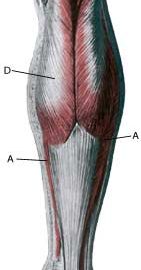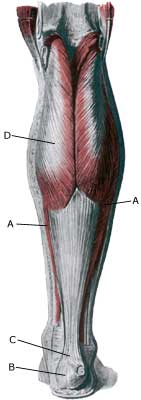MUSCLE RUPTURE IN THE CALF
|
||
|
||
| Cause: When a muscle is subjected to a load beyond the strength of the muscle, a rupture occurs. The vast majority of ruptures are partial muscle ruptures. The weakest point is often between the fascia and the meaty part of the muscle.
Symptoms: In light cases a local tenderness is felt after being subject to load (“sprained muscle”, “imminent pulled muscle”). In severe cases sudden shooting pains are felt in the muscle (“partial muscle rupture”, “pulled muscle”) and in the worst case a sudden snap is felt rendering the muscle unusable (“total muscle rupture”). With muscle injuries the following three symptoms are characteristic: pain upon applying pressure, stretching and activation of the calf muscle against resistance. With total ruptures a defect can often be seen and felt in the muscle, and above and below the rupture a swelling can be felt (the contracted muscle belly and bleeding). The most frequent place for ruptures on the lower leg is in the inner (medial) part of the calf muscle on the transition between the muscle belly and the tendon part of the muscle (“Tennis leg”). Acute treatment: Click here. Examination: In light cases (“sprained muscle”) with only minimal tenderness and no discomfort when walking normally, medical examination is not necessarily required. The severity of the tenderness is however, not always a measure of the extent of the injury. In cases of more pronounced tenderness or pain, medical examination is required to ensure the diagnosis and treatment. A normal medical examination is usually sufficient in order to make the diagnosis, however, if there is any doubt concerning the diagnosis an ultrasound scan can be performed to ensure the diagnosis (article) (Ultrasonic image). Treatment: The treatment of the vast majority of muscle injuries today involves relief and rehabilitation (article). In some cases with total ruptures, surgery can be considered. Complications: If the course does not progress smoothly, you should be medically re-examined to ensure that the diagnosis is correct, and that complications to muscle ruptures have not arisen. |


